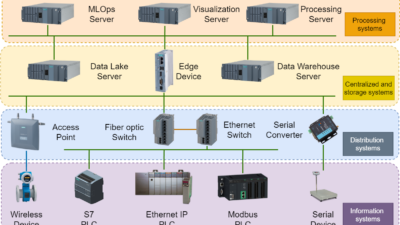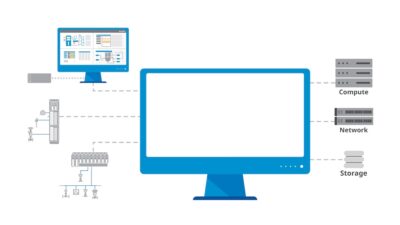The metaverse is evolving for industrial use, and the foundation, going forward, will be digital twins, blockchain and the Internet of Things (IoT).

Learning Objectives
- Digital twins, blockchain and the Internet of Things (IoT) will help power the metaverse..
- Digital twins are the building block, blockchain are the transactional engine and the IoT serves as the infrastructure.
Industrial Metaverse Insights
- The metaverse is a hypothetical iteration of the internet as a virtual reality (VR). Once thought to be the idea of science fiction, it is becoming very much a reality as VR and augmented reality (AR) grow in use.
- For manufacturers and industrial automation companies, digital twins, blockchain and the Internet of Things (IoT) will be powering the metaverse.
While video gaming and entertainment are its best-known turf, the metaverse is so much more than just a hangout and has growing number of tools useful for industrial applications. Also, there are a lot more technologies than augmented reality (AR) and virtual reality (VR) at work. There are three things that will power the metaverse going forward: Digital twins, blockchain and the IoT. Digital twins are building the virtual metaverse
As the virtual replica of a real-world object or system, a digital twin can be thought of as a building block of the metaverse. A lot of technology, including sensors, machine learning (ML), artificial intelligence (AI), communications and real-time data, goes into a digital twin, so it can mimic physical subjects – things, people, and places – down to the last detail, simulate events and processes, and provide insights to aid decision-making.
Because it is a virtual copy of the physical original, including its changes and movements, a digital twin makes the metaverse and its experiences seem very nearly real. Imagine, for instance, driving with a street map digital twin that exactly depicted a road, its buildings, traffic and other features in real-time. Or how authentic it would seem if a digital avatar started to sweat when its human entity was doing the same in a Florida summer.
The digital twin is not new to industrial automation, being widely used in smart manufacturing since several years to improve every area of operations.
In the metaverse, the possibilities of digital twin technology become bigger and brighter. For example, automobile companies who are already using digital twins to model cars, and their performance, may launch them in an automobile expo in the metaverse in the not too distant future.
Distributed service teams of an industrial manufacturing company would meet in the metaverse and tinker with a digital replica of faulty equipment. In the age of hybrid work, people working from home would show up in the digital twin of their offices and not feel like they were missing out.
How blockchain is powering the metaverse economy
Apart from hardware devices, the metaverse needs an environment for exchanging data with users. Blockchain is seen as the ideal option, because of its inherent advantages including security, trustworthiness, decentralized character and interoperability. Importantly, it offers a mechanism for users to safeguard and show ownership of virtual assets, a capability that is enriching the metaverse’s use cases in many ways. For example, unique cryptographic assets on blockchain, also known as non-fungible tokens (NFTs), are being used to prove ownership of digital assets in gaming, (digital) art and music. For example, Axie Infinity and The Sandbox gamers are already building and trading their digital properties through NFTs. So, when they go from one metaverse to another, they can carry their assets along in the form of these tokens.
Blockchain and other distributed ledgers underlie cryptocurrency, which will soon pervade the metaverse as virtual purchasing takes off. Like money in the real world, cryptocurrency also will be lent, borrowed and invested – albeit in a decentralized manner – in the metaverse in the near future.
Citizens of the metaverse also will secure their biggest asset, their identity information, on the blockchain ledger, confident it will not be stolen, tampered with or misused.
IoT bringing the metaverse together
One challenge in expanding the metaverse is that it requires massive new infrastructure to host its constituent technologies. A metaverse platform needs to connect physical devices, gadgets and hardware, to collect data. This is possible with IoT, which is powered by the cloud.
As the environment that gathers and disseminates data from the physical world to represent it in the virtual one, the IoT is what makes the metaverse not just work, but work well. The IoT’s ecosystem of connected objects captures synthetic data to create “real-like” sensations – visual, auditory, experiential – in metaverse avatars. For instance, it takes human body information, such as movement or direction of gaze, from wearable devices or tags to create very realistic personas and experiences.
Everyone agrees that the metaverse is huge and happening. However, we are yet to get the measure of this virtual world, or more accurately, worlds. What’s clear is the metaverse applications extend beyond a few technologies for entertainment. With growing AI to AR applications, the metaverse presents a compelling use case for every digital technology.
Three technologies are key to the future of the metaverse – digital twin, its building block; blockchain, its transactional engine; and IoT, its foundational infrastructure.
Gopikrishnan Konnanath is senior vice president and global head, Infosys. Edited by Chris Vavra, web content manager, Control Engineering, CFE Media and Technology, [email protected].
MORE INNOVATIONS
Keywords: Internet of Things, metaverse
ONLINE
See additional IIoT, Industry 4.0 stories at https://www.controleng.com/iiot-industrie-4-0/
CONSIDER THIS
How is your company preparing for industrial metaverse applications?



